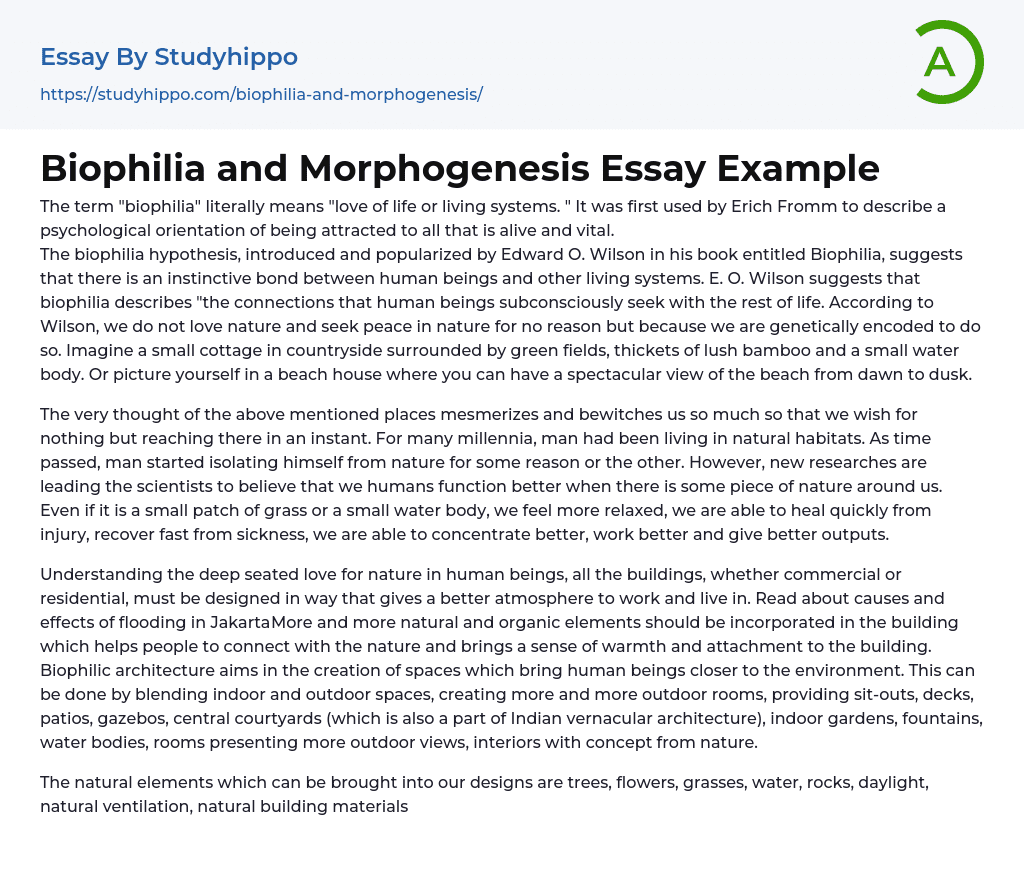Edward O. later expanded on and popularized the biophilia hypothesis.
Wilson, in his book Biophilia, proposes the existence of an innate connection between humans and other living systems. He describes biophilia as the subconscious longing for connections with all forms of life.
According to Wilson, our genetic composition is responsible for our desire and longing for peace in natural environments. The image of a cozy rural home surrounded by lush green fields, dense bamboo forests, and a calm body of water or a seaside residence with breathtaking views from morning till night captivates us and creates such a strong enchantment that it instantly triggers a yearning
...within us.
Throughout history, humans have inhabited natural environments. However, they gradually separated themselves from nature for different reasons. Yet, recent research indicates that being in proximity to nature has a beneficial effect on human well-being. Whether it's a small area of grass or a tiny body of water, having nature nearby encourages relaxation, expedites the healing process, boosts concentration and efficiency, and enhances overall performance.
In order to create a more welcoming environment in commercial and residential buildings, it is crucial to recognize and embrace humanity's strong connection with nature. One way to achieve this is through biophilic architecture, which aims to design spaces that allow individuals to connect with the natural world. This can be accomplished by incorporating elements such as trees, flowers, grasses, water, rocks, daylight, and natural ventilation into the building's
structure. It is also important to seamlessly blend indoor and outdoor spaces together by including features like outdoor rooms, sit-outs, decks, patios, gazebos, central courtyards (a characteristic of Indian vernacular architecture), indoor gardens, fountains,and water bodies. Additionally,the interiors should draw inspiration from nature and utilize natural building materials like wood and stone. The presence of naturalistic ornamentation like flowers further enhances the bond between humans and nature.
Read about
causes and effects of flooding in Jakarta
Biophilic design integrates organic shapes from nature, which provide a more natural and harmonious aesthetic compared to man-made geometrical shapes. It also emphasizes using naturally inspired color schemes.
Incorporating dynamic natural light is a crucial aspect of biophilic design. This is accomplished by strategically positioning windows and skylights in buildings to capture the ever-changing qualities of natural light. By allowing light to enter spaces from at least two different directions, one can enhance the experience of the sun's movement while reducing glare and creating diverse patterns of brightness and shadow.
One advantage of spacious floor-to-ceiling windows is the pleasant garden view they offer. Additionally, adequate air circulation is crucial for ensuring proper ventilation in rooms. People generally prefer rooms with ample fresh air to enclosed spaces as it contributes to their comfort and overall well-being.
The third component is access to open or moving water. Moving water has a positive effect on our minds and the sound produced by it helps us in calming down. Biophilic architecture and sustainable architecture go hand in hand. The courtyard concept, which brings us close to nature, also increases the circulation of air during the day as
the temperature rises and helps distribute the heat at night when it cools down. Similarly, green roofs, which connect us with nature even when we dwell in a concrete jungle, lower the temperature by 6-7 degrees Celsius during summers. Thus, we can see that biophilic architecture works in harmony with sustainable architecture.
Today's architects do not have to copy foreign things. Instead, they can simply incorporate the essence of nature into their spaces and designs, thereby creating a sense of warmth and connection with the building among people.
- Arch essays
- Area essays
- Building essays
- Oxygen essays
- Atmosphere essays
- Coral Reef essays
- Desert essays
- Earth essays
- Ocean essays
- Lake essays
- Sea essays
- Biodiversity essays
- Natural Environment essays
- Forest essays
- Soil essays
- Water essays
- Rainbow essays
- Ecosystem essays
- Volcano essays
- Wind essays
- Forestry essays
- Bottled Water essays
- Architecture essays
- Design essays
- Graffiti essays
- Graphic essays
- Interior design essays
- Painting essays
- Photography essays
- Sculpture essays
- Typography essays
- Automotive essays
- Automotive Industry essays
- Commerce essays
- Construction essays
- E Commerce essays
- Grocery stores essays
- Paper Industry essays
- Pharmaceutical industry essays
- Pharmacy essays
- Polymers essays
- Real Estate essays
- Textile Industry essays
- 1984 essays
- A Farewell to Arms essays
- A Good Man Is Hard to Find essays
- A Hanging essays
- A Lesson Before Dying essays
- A Long Way Gone essays
- A Rose For Emily essays




